Overview
-
Pros
- Excellent build quality and design
- High resolution touch enabled display
- Good performance
- Good battery life
-
Cons
- The keyboard is a mess
- The Clickpad has a vague feel
- No extended-life battery option
- Soldered memory chips
The new ThinkPad X1 Carbon is Lenovo’s halo
entry into the high-end business Ultrabook market. This product features
the very latest in technology including a WHQD (2560×1440 resolution)
display with touch support, carbon fiber construction, backlit adaptive
keyboard, fourth-gen Intel dual-core processors and up to 512GB of SSD
storage. We’re keen on the design but have some grumbles about the
keyboard and touchpad which ultimately make it fall short of the
competition.
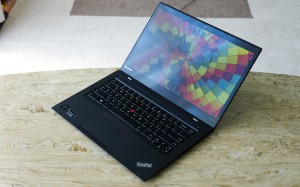
Build and Design
The X1 Carbon’s exterior design has the all-black business look we’ve
come to expect over the years from ThinkPads except this one is much
sleeker; it’s just eight-tenths of an inch thin at the highest point and
a shade less than three pounds. The chassis is exceptionally strong
despite this thanks to its carbon fiber construction. The lid’s strength
is impressive; it’s the most rigid I’ve seen on an Ultrabook. I was
unable to get ripples to appear in the display even applying an
excessive amount of pressure on the back. Lid strength is an often
overlooked attribute of build quality for notebooks that see frequent
handling and travel; the display panel can distort and fail over time if
pressures like that affect it.
The display hinge is stiff enough to prevent any excessive wobbling when touching the display however stiff enough two hands are required to open it. The X1 Carbon’s fit and finish is very good; all of its pieces fit together tightly and with even spacing.
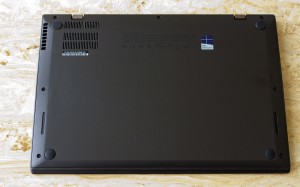 Seven
screws hold the X1 Carbon’s bottom cover to the rest of the chassis;
these are fortunately Phillips screws unlike other Ultrabooks which use
Torx or another proprietary design. The X1 Carbon’s options for user
upgrades are very limited; the RAM is non-upgradeable since it’s
soldered to the motherboard and there are no open slots. It accepts only
the new M.2 specification SSDs which are new and have limited selection
at the time of this writing. Besides the SSD, the only user-changeable
component is the wireless card and the X1 Carbon already comes with the
best currently available, the Intel Dual-Band Wireless AC-7260.
Seven
screws hold the X1 Carbon’s bottom cover to the rest of the chassis;
these are fortunately Phillips screws unlike other Ultrabooks which use
Torx or another proprietary design. The X1 Carbon’s options for user
upgrades are very limited; the RAM is non-upgradeable since it’s
soldered to the motherboard and there are no open slots. It accepts only
the new M.2 specification SSDs which are new and have limited selection
at the time of this writing. Besides the SSD, the only user-changeable
component is the wireless card and the X1 Carbon already comes with the
best currently available, the Intel Dual-Band Wireless AC-7260.
Input and Output Ports
The X1 Carbon has a limited selection of input/output ports as expected from an Ultrabook but covers the basics with two USB 3.0 ports, HDMI and mini-DisplayPort. Ethernet connectivity is provided via dongle (the chassis is too thin to accommodate the port, apparently). Unfortunately there is no built-in media card reader, so you’ll need an external card reader if you want to transfer images from your digital camera. All picture descriptions are left to right.
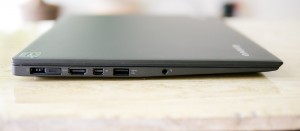
Left: AC power jack, HDMI, mini-DisplayPort, USB 3.0, headphone/microphone combo jack
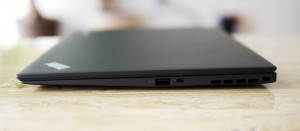
Right: USB 3.0, Ethernet dongle connector, cooling exhaust vent, Kensington lock slot
Keyboard and Touchpad
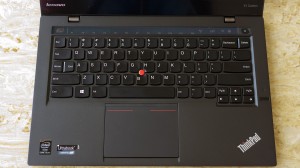 The
X1 Carbon has a full-size ‘Chiclet’ style keyboard; it has white LED
backlighting with three levels of brightness including fully off. This
is what Lenovo calls an adaptive keyboard – notice that the top-row
Function keys ([F1], [F2] and so on) are absent; a touch-sensitive strip
resides in their place with a digital background. Different functions
display depending on the mode; for example the standard Function layout
displays the traditional [F1] – [F12] keys. Other modes include Home
which displays volume and screen brightness controls, quick access to
Search, Windows 8 Apps and the Snipping Tool; Web Browser mode which has
back, refresh and new tab buttons; and finally Web Conference mode
which has microphone settings and levels.
The
X1 Carbon has a full-size ‘Chiclet’ style keyboard; it has white LED
backlighting with three levels of brightness including fully off. This
is what Lenovo calls an adaptive keyboard – notice that the top-row
Function keys ([F1], [F2] and so on) are absent; a touch-sensitive strip
resides in their place with a digital background. Different functions
display depending on the mode; for example the standard Function layout
displays the traditional [F1] – [F12] keys. Other modes include Home
which displays volume and screen brightness controls, quick access to
Search, Windows 8 Apps and the Snipping Tool; Web Browser mode which has
back, refresh and new tab buttons; and finally Web Conference mode
which has microphone settings and levels.
The adaptive keyboard strip is a notable exercise in innovation but falls short on usability. I appreciated its handy auto-switch feature that changes the mode depending on the application; it switches to Web Browser mode automatically when using Internet Explorer for example. The Function keys conveniently show up when the [Alt] key is pressed as well. The general usability issue is that there is a near complete lack of tactile feedback; you’re unsure a “key press” registered until something happens on-screen. And while the keys are in their expected positions, it’s tough to use them by feel since there are no physical keys. One particular annoyance is that the Function keys don’t show up instantly when pressing [Alt]; keyboard shortcut junkies used to pressing [Alt] + [F4] to close an application for example will find this almost unbearable since that shortcut is usually one fluid motion but on this keyboard is two parts; pressing [Alt], waiting for the Function keys to display and then tapping where [F4] should be. It’s less than ideal and not at all intuitive. Overall the adaptive keyboard’s merits fail to counteract the deficiencies it bestows upon experienced touch typists and those that rely on standard keyboard shortcuts.
I have middling feelings about the rest of the keyboard. The tactile feedback is excellent primarily because unlike many Ultrabooks, the X1 Carbon’s keys have plenty of travel (distance between pressed and un-pressed positions) for a communicative typing experience. The keyboard tray has no flex and the keys themselves make a subdued sound, good for working in quiet environments. The middling feelings come from layout problems. The Caps Lock key is gone and replaced with the Home and End keys; to enable Caps Lock, press the left Shift key twice. This will throw you for a loop if you’re a frequent user of the aforementioned keys especially if you use other computers besides this one (thus switching between layouts and never becoming accustomed to this one). The tilde (~) key has been moved from under the [Esc] key to the right of the spacebar and the Page Up and Page Down keys are now part of the arrow key cluster.
In addition, the Backspace and Delete keys are oddly joined together in the same space the backspace key would normally occupy by itself. Furthermore there are no Printscreen or Insert keys. I find these layout choices baffling considering the amount of real estate available on this chassis to simply use a standardized layout; so why do this? I’d condone the changes if they improved productivity but the net effect is far in the other direction. Many years back I would’ve never forseen the day that I had such fundamental issues with a ThinkPad keyboard, the once gold standard. It saddened me to type what I just typed (not to mention I did so on the X1 Carbon’s keyboard).
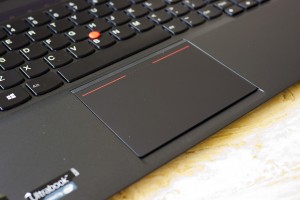 The
touchpad is actually a clickpad; press down anywhere to produce a
click. As with numerous other makers who attempted clickpad
implementations, Lenovo’s version falls short in practicality compared
to a traditional two-button touchpad setup. The clickpad is
appropriately sized for a 14″ screen and has a pleasant matte surface;
the issue is however that the clicks are inaccurate. The clickpad
surface has too much travel which makes it feel trampoline-like and as a
result, imprecise. The clicks are in addition much too loud; someone
across a relatively quiet conference room can easily hear a click. Per
ThinkPad tradition, the X1 Carbon has a pointing stick in the center of
the keyboard but unlike ThinkPad tradition, no dedicated set of buttons;
awkward is the best way to describe using the clickpad as buttons
especially since you have to press all the way at the bottom right of
the clickpad to perform a right-click.
The
touchpad is actually a clickpad; press down anywhere to produce a
click. As with numerous other makers who attempted clickpad
implementations, Lenovo’s version falls short in practicality compared
to a traditional two-button touchpad setup. The clickpad is
appropriately sized for a 14″ screen and has a pleasant matte surface;
the issue is however that the clicks are inaccurate. The clickpad
surface has too much travel which makes it feel trampoline-like and as a
result, imprecise. The clicks are in addition much too loud; someone
across a relatively quiet conference room can easily hear a click. Per
ThinkPad tradition, the X1 Carbon has a pointing stick in the center of
the keyboard but unlike ThinkPad tradition, no dedicated set of buttons;
awkward is the best way to describe using the clickpad as buttons
especially since you have to press all the way at the bottom right of
the clickpad to perform a right-click.
Screen and Speakers
The X1 Carbon is offered with two 14-inch display choices: the base 1600×900 resolution TN panel and the upgraded WQHD version on our review unit. The WQHD display is cutting edge; it features an ultra-high 2560×1440 resolution (a standard 1920×1080 (1080p) display has just 56% of the pixels by comparison), anti-glare surface, IPS panel technology and 10 touch point support. Color depth and contrast are outstanding; anything with color stands out. This display is plenty bright at 300 nits, enough to use outdoors on a sunny day. Backlight uniformity is generally good though there is some bleeding from around the edges especially the bottom. The IPS technology is what allows this display to have unlimited viewing angles; the picture looks the same no matter what angle you’re viewing. Despite this I did notice the brightness varied significantly depending on whether the display was viewed head-on or not. Changes in color were minimal however.
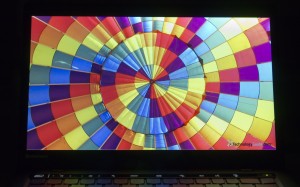
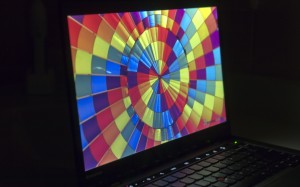
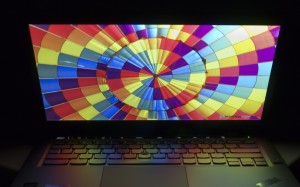
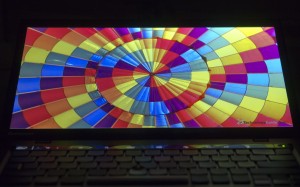
In terms of sound performance there are two small side-facing stereo speakers located under the palm rests. They have a surprisingly spacious soundstage and get louder than expected. The bass is faint but present. This setup suffices for personal listening but two people watching a feature film would likely be left wanting.

Build and Design
The display hinge is stiff enough to prevent any excessive wobbling when touching the display however stiff enough two hands are required to open it. The X1 Carbon’s fit and finish is very good; all of its pieces fit together tightly and with even spacing.
 Seven
screws hold the X1 Carbon’s bottom cover to the rest of the chassis;
these are fortunately Phillips screws unlike other Ultrabooks which use
Torx or another proprietary design. The X1 Carbon’s options for user
upgrades are very limited; the RAM is non-upgradeable since it’s
soldered to the motherboard and there are no open slots. It accepts only
the new M.2 specification SSDs which are new and have limited selection
at the time of this writing. Besides the SSD, the only user-changeable
component is the wireless card and the X1 Carbon already comes with the
best currently available, the Intel Dual-Band Wireless AC-7260.
Seven
screws hold the X1 Carbon’s bottom cover to the rest of the chassis;
these are fortunately Phillips screws unlike other Ultrabooks which use
Torx or another proprietary design. The X1 Carbon’s options for user
upgrades are very limited; the RAM is non-upgradeable since it’s
soldered to the motherboard and there are no open slots. It accepts only
the new M.2 specification SSDs which are new and have limited selection
at the time of this writing. Besides the SSD, the only user-changeable
component is the wireless card and the X1 Carbon already comes with the
best currently available, the Intel Dual-Band Wireless AC-7260.Input and Output Ports
The X1 Carbon has a limited selection of input/output ports as expected from an Ultrabook but covers the basics with two USB 3.0 ports, HDMI and mini-DisplayPort. Ethernet connectivity is provided via dongle (the chassis is too thin to accommodate the port, apparently). Unfortunately there is no built-in media card reader, so you’ll need an external card reader if you want to transfer images from your digital camera. All picture descriptions are left to right.

Left: AC power jack, HDMI, mini-DisplayPort, USB 3.0, headphone/microphone combo jack

Right: USB 3.0, Ethernet dongle connector, cooling exhaust vent, Kensington lock slot
Keyboard and Touchpad
 The
X1 Carbon has a full-size ‘Chiclet’ style keyboard; it has white LED
backlighting with three levels of brightness including fully off. This
is what Lenovo calls an adaptive keyboard – notice that the top-row
Function keys ([F1], [F2] and so on) are absent; a touch-sensitive strip
resides in their place with a digital background. Different functions
display depending on the mode; for example the standard Function layout
displays the traditional [F1] – [F12] keys. Other modes include Home
which displays volume and screen brightness controls, quick access to
Search, Windows 8 Apps and the Snipping Tool; Web Browser mode which has
back, refresh and new tab buttons; and finally Web Conference mode
which has microphone settings and levels.
The
X1 Carbon has a full-size ‘Chiclet’ style keyboard; it has white LED
backlighting with three levels of brightness including fully off. This
is what Lenovo calls an adaptive keyboard – notice that the top-row
Function keys ([F1], [F2] and so on) are absent; a touch-sensitive strip
resides in their place with a digital background. Different functions
display depending on the mode; for example the standard Function layout
displays the traditional [F1] – [F12] keys. Other modes include Home
which displays volume and screen brightness controls, quick access to
Search, Windows 8 Apps and the Snipping Tool; Web Browser mode which has
back, refresh and new tab buttons; and finally Web Conference mode
which has microphone settings and levels.The adaptive keyboard strip is a notable exercise in innovation but falls short on usability. I appreciated its handy auto-switch feature that changes the mode depending on the application; it switches to Web Browser mode automatically when using Internet Explorer for example. The Function keys conveniently show up when the [Alt] key is pressed as well. The general usability issue is that there is a near complete lack of tactile feedback; you’re unsure a “key press” registered until something happens on-screen. And while the keys are in their expected positions, it’s tough to use them by feel since there are no physical keys. One particular annoyance is that the Function keys don’t show up instantly when pressing [Alt]; keyboard shortcut junkies used to pressing [Alt] + [F4] to close an application for example will find this almost unbearable since that shortcut is usually one fluid motion but on this keyboard is two parts; pressing [Alt], waiting for the Function keys to display and then tapping where [F4] should be. It’s less than ideal and not at all intuitive. Overall the adaptive keyboard’s merits fail to counteract the deficiencies it bestows upon experienced touch typists and those that rely on standard keyboard shortcuts.
I have middling feelings about the rest of the keyboard. The tactile feedback is excellent primarily because unlike many Ultrabooks, the X1 Carbon’s keys have plenty of travel (distance between pressed and un-pressed positions) for a communicative typing experience. The keyboard tray has no flex and the keys themselves make a subdued sound, good for working in quiet environments. The middling feelings come from layout problems. The Caps Lock key is gone and replaced with the Home and End keys; to enable Caps Lock, press the left Shift key twice. This will throw you for a loop if you’re a frequent user of the aforementioned keys especially if you use other computers besides this one (thus switching between layouts and never becoming accustomed to this one). The tilde (~) key has been moved from under the [Esc] key to the right of the spacebar and the Page Up and Page Down keys are now part of the arrow key cluster.
In addition, the Backspace and Delete keys are oddly joined together in the same space the backspace key would normally occupy by itself. Furthermore there are no Printscreen or Insert keys. I find these layout choices baffling considering the amount of real estate available on this chassis to simply use a standardized layout; so why do this? I’d condone the changes if they improved productivity but the net effect is far in the other direction. Many years back I would’ve never forseen the day that I had such fundamental issues with a ThinkPad keyboard, the once gold standard. It saddened me to type what I just typed (not to mention I did so on the X1 Carbon’s keyboard).
 The
touchpad is actually a clickpad; press down anywhere to produce a
click. As with numerous other makers who attempted clickpad
implementations, Lenovo’s version falls short in practicality compared
to a traditional two-button touchpad setup. The clickpad is
appropriately sized for a 14″ screen and has a pleasant matte surface;
the issue is however that the clicks are inaccurate. The clickpad
surface has too much travel which makes it feel trampoline-like and as a
result, imprecise. The clicks are in addition much too loud; someone
across a relatively quiet conference room can easily hear a click. Per
ThinkPad tradition, the X1 Carbon has a pointing stick in the center of
the keyboard but unlike ThinkPad tradition, no dedicated set of buttons;
awkward is the best way to describe using the clickpad as buttons
especially since you have to press all the way at the bottom right of
the clickpad to perform a right-click.
The
touchpad is actually a clickpad; press down anywhere to produce a
click. As with numerous other makers who attempted clickpad
implementations, Lenovo’s version falls short in practicality compared
to a traditional two-button touchpad setup. The clickpad is
appropriately sized for a 14″ screen and has a pleasant matte surface;
the issue is however that the clicks are inaccurate. The clickpad
surface has too much travel which makes it feel trampoline-like and as a
result, imprecise. The clicks are in addition much too loud; someone
across a relatively quiet conference room can easily hear a click. Per
ThinkPad tradition, the X1 Carbon has a pointing stick in the center of
the keyboard but unlike ThinkPad tradition, no dedicated set of buttons;
awkward is the best way to describe using the clickpad as buttons
especially since you have to press all the way at the bottom right of
the clickpad to perform a right-click.Screen and Speakers
The X1 Carbon is offered with two 14-inch display choices: the base 1600×900 resolution TN panel and the upgraded WQHD version on our review unit. The WQHD display is cutting edge; it features an ultra-high 2560×1440 resolution (a standard 1920×1080 (1080p) display has just 56% of the pixels by comparison), anti-glare surface, IPS panel technology and 10 touch point support. Color depth and contrast are outstanding; anything with color stands out. This display is plenty bright at 300 nits, enough to use outdoors on a sunny day. Backlight uniformity is generally good though there is some bleeding from around the edges especially the bottom. The IPS technology is what allows this display to have unlimited viewing angles; the picture looks the same no matter what angle you’re viewing. Despite this I did notice the brightness varied significantly depending on whether the display was viewed head-on or not. Changes in color were minimal however.




In terms of sound performance there are two small side-facing stereo speakers located under the palm rests. They have a surprisingly spacious soundstage and get louder than expected. The bass is faint but present. This setup suffices for personal listening but two people watching a feature film would likely be left wanting.
0 komentar:
Posting Komentar